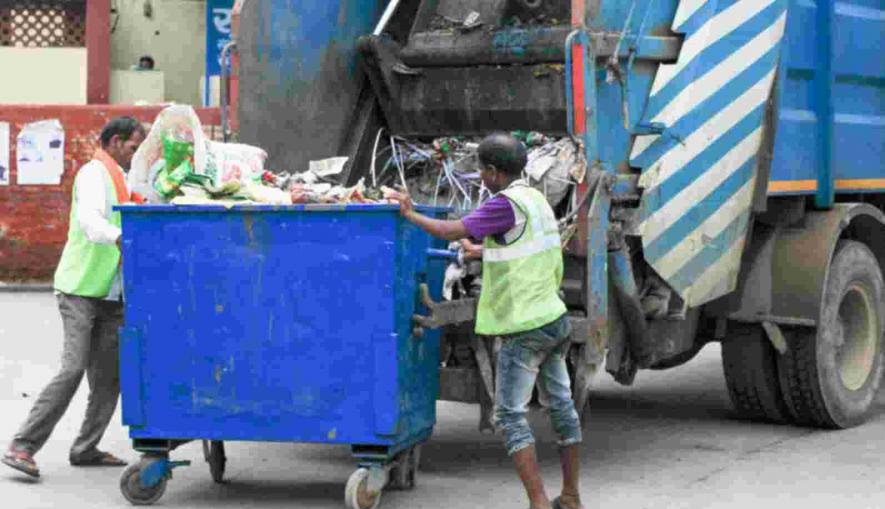‘A Sanitation Worker’s Life is as Valuable as that of Other Castes’

Representational Image. Image Courtesy: Shutterstock Stock
Mohit Yadav, National Coordinator of the Sulabh Sewa Campaign, Mumbai, and Ashutosh Ranga, National Secretary and legal advisor with the Aashray Do Campaign, Delhi, interview Pragya Akhilesh, national convener of the Rehabilitation Research Initiative, India and secretary of the Bhim Safai Karmachari Trade Union. She speaks about the Covid-19 pandemic and criticises the government’s preoccupation with building sanitation infrastructure instead of resolving on-ground issues of sanitation workers. For example, the government has failed to recognise that the toilets it is building also have to be cleaned, often at risk to the life and health of sanitation workers. Edited excerpts.
You recently found that 46,000 newer dry latrines were built during the ongoing pandemic. What are the reasons for this?
During the pandemic, we found that newer dry latrines were coming up every day. It indicates that more importance should be given to the value of service of previously-constructed toilets than the number of toilets being built. The newer dry latrines are also a result of poor sanitation infrastructure and the bad condition of sanitary toilets in India. We are going backwards in terms of sanitation coverage. Each “hanging toilet” within a small informal settlement is also a result of the distance of the sanitary toilet built under the Swachch Bharat Mission from where people who need to use them live. These 46,000 are only the new dry latrines that we found during the pandemic. The real figures on the ground would be way higher.
You wrote in The Indian Express that around twenty major categories of sanitation workers need to be included in the Manual Scavenging Act, 2013. Why is there a need to include more categories of workers?
The acts and schemes related to sanitation workers should focus on all excluded groups of sanitation workers, such as the faecal sludge handlers, the sewage treatment plant sanitation workers, the toilet sanitation workers engaged in the community, public, school, and domestic household toilets, which are further classified into dry or wet handling. Further, they should include public transportation site sanitation workers, such as on the railways and roads, on sewer and drain sanitation workers, on septic tank workers, waste recovery workers (in households, communities and landfills, further classified into resource-recovery sanitation workers), operational sanitation workers and sanitation waste intersection workers.
The regulations should also cover workers who, in some cases, manually scavenge biomedical and hazardous wastes. They should be further classified into who the manual scavengers actually are. The pandemic has also thrown more light on the “bone scavengers” of India. We need to amend the loopholes in the Manual Scavenging Act. The sanitation workers of India have already assessed the obsolete parts of this Act.
What information has their assessment thrown up and what are their demands?
For example, on every sewer death, sanitation workers get pressured into stating that they entered the sewer “voluntarily”. This is a result of the serious lags in the Manual Scavenging Act. It needs restructuring and amendments. Sanitation workers are also asking questions about the failure of amendments. The workers now know that the clear-cut focus of this government is only on building newer toilets—it is neither interested in assessing the functionality or use of the older ones nor in who is forced to maintain these toilets. It is the workers themselves who are leading this march for changing this system all over India. The same story repeats in every sanitation worker hearing we conduct.
Why do we need to stop using the term Safai Mitra when we talk about sanitation workers in India and instead use the term Safai Karmachari Mitra?
Last year, the Safaimitra Suraksha Challenge was launched on November 19, World Toilet Day. As sanitation workers continue to die while cleaning septic tanks, the need for the government to reassess its policies and schemes is growing. That is why the Safai Mitra needs to be converted into the Safai Karmachari Mitra because that brings the focus on the rights and dignity of those who are doing the job of cleaning.
During the peak of the second wave, hundreds of corpses were being buried on the banks of Ganga or washed away into the rivers. At the time, India’s sanitation workers were struggling to make it to the end of the day, dealing with one body at a time. The bloated bodies that landed on the riversides in Uttar Pradesh and Bihar were buried by local sanitation workers at risk to their lives, without proper gear or protective equipment.
Each day, they survived numerous death threats but kept serving the people. In hospitals, sanitation workers wrapped and unwrapped bodies with minimum safety. This is exactly how the upper castes got away by burdening them for hundreds of years. We need an un-Brahmanical approach to help the sanitation workers. I am saying this because sanitation is a caste-based occupation. The life of a sanitation worker is of as much value as the life of people who belong to other castes in India.
How exactly will a name change help?
The Centre has a record of failing sanitation workers. Sanitation workers are not interested in being called “Swachhata Commandos” or “Covid warriors”. The conversion of “Safai Mitra” into “Safai Karmachari Mitra” should be actualized through systematic policy integrations and hand-holding. Otherwise, it will be yet another Manhole-to-Machinehole promise, just on paper. Sanitation workers should be in central positions in existing central and state-level schemes, in terms of the budgetary allocations, policies and laws that relate to them and their work.
You have repeatedly said that India’s sanitation workers are forced to “manually scavenge” toilets in India. Please share more details about this.
The poor condition of toilets was palpable during the pandemic. They became hotbeds for disease-spread. People in rural areas were so scared to use toilets that they could defecate anywhere except inside those structures. Yet we keep emphasising on ODF [Open Defecation Free] status for all urban local bodies.
Women come to us to tell us how they have to use strong bleaching agents to clean toilets. The bleach causes permanent burns on their skin and damages the tissues in their eyes. The important question is, what will the government achieve with its plans to construct a toilet every two seconds when it is failing to protect those who are forced to “manually scavenge” it?
You have attempted to change India’s sanitation narrative in the last decade by bringing to light the conditions of lakhs of toilets. What has been your most important observation or learning?
India’s sanitation narrative has to be understood not just in terms of coverage but also through the interconnectedness of water and sanitation and the links between sanitation infrastructure, sanitation behaviour and sanitation labour in India. One cannot be understood without the other. Unfortunately, studies in this field are fragmented into single streams. The conversation on toilets cannot be complete without assessing and fixing the problems of the ones who are forced to maintain it.
Celebrating “Rashtriya Swachhta Diwas” on 2nd October reflects the poor grasp of our people on the issues of sanitation workers. According to BR Ambedkar, the Hindus of India have always had a curious “deep ingrained ethnocentrism which has time and again prevented them from reconstruction of the Hindu society”. Therefore, when we indulge in “infrastructure-building”, more than real issues, corruption usually goes unnoticed. Building infrastructure is much easier than solving grassroots issues. This is also the reason for the high contrast between India’s urban and rural water and sanitation coverage and the poor conditions of sanitation workers in India.
The conversations on sanitation workers, too, should be by the sanitation workers for the sanitation workers and of the sanitation workers. They have already started this revolution in 1993. People such as Bezwada Wilson and KB Obalesh have fought led movements with these demands for decades. My work has only been to interconnect the various streams related to water and sanitation in India, focusing on one toilet at a time.
Get the latest reports & analysis with people's perspective on Protests, movements & deep analytical videos, discussions of the current affairs in your Telegram app. Subscribe to NewsClick's Telegram channel & get Real-Time updates on stories, as they get published on our website.
























